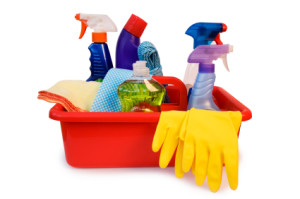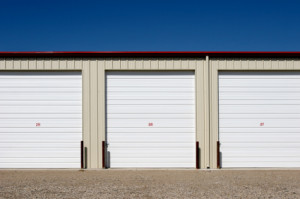Archive for the 'Storage' Category

Consider these storage solutions for your small space.
By Stephen Davis
Special to Relocation.com
When your space is limited in your new apartment or dorm room, you may end up wondering just where to put stuff so that you don’t end up with tons of clutter. Luckily, there are some pretty and creative ways to store things. It just takes some time and imagination.
The first thing you can do is to evaluate your belongings. If there are items that you really don’t need, get rid of them. You only want to store the things you really need and want and all the rest is just useless clutter.
Think vertically. Once you have cleaned out the useless stuff, it is time to take a look around at just where you can be creative. One thing you can do is to think vertically. Try a bookcase that reaches the ceiling, for instance. You can display a lot on a floor to ceiling bookcase; everything from books to photo albums, magazines and knick-knacks can be put on those shelves. Consider a tall bookcase as a headboard for your bed.
Use the inside of closet and cabinet doors. You can buy plastic hanging shoe-holders, for instance, and put a ton of stuff into them. In the kitchen you can even store small containers, utensils or spices in them. In the bathroom you can roll up towels and put into those pockets, or spare toiletries. For the bathroom, a small wine rack can hold a lot of towels and washcloths as well.
Use storage underneath. Another space you can utilize is under the coffee table or end tables. Get nice looking containers that will fit under these, or try using steamer trunks. You can even use trunks as your coffee table! Look under things for available space. Under the bed is a perfect place to store things, too. You can buy some boxes especially made for under a bed. In a child’s room, consider getting a captain’s bed that has drawers built into it.
Use hooks. In the kitchen, consider the use of hooks on the wall to hang pots and pans, strainers, utensils or whatever. Creatively arranged hooks can really look nice, and it will give you tons of storage. A pot holder that hangs from the ceiling is also a great space saver. Store food items like rice, cereal and the like in stacking plastic containers that take up a lot less room than the boxes the food comes in.
Consider items that double as storage. For instance, a foot stool or ottoman that has storage inside of it will be a great place to store things in. Using a small chest of drawers in the entryway can hold all your items like keys, umbrellas and things like that. You can even use a short chest of drawers as a coffee table! Install shelves high up on the walls of rooms to hold things.
Even the smallest of spaces can be maximized for storage. All you really need to think outside of the box and use some handy storage solutions (and your space) effectively.
Don’t forget to like us on Facebook and follow us on Twitter!
• Follow us on Twitter @Relocation_News
• Become a fan of Relocation.com on Facebook

Congratulations on moving in - now it's time to unpack and finally settle in.
You did it – you finally moved it! Although the moving companies are long gone you now have a sea of moving boxes, unpainted walls and a bare home to deal with. Before you go crazy with the unpacking, we advise setting up a plan so that you can quickly settle-in and enjoy your new home.
1. Go out to dinner. No, this isn’t a plot to aid in your procrastination. We simply think that taking break after the days (and sometimes months) leading up to a move is a healthy way to re-focus on your plan. Getting out of the house is a great stress-reliever that will (hopefully) allow you to think about something else other than those boxes at home. Plus, having a relaxed dinner is also a great way to check out a restaurant or neighborhood in your new town or city.
2. Make it a party. If you can’t manage to break away from your unsettled home, consider having a painting and/or unpacking party. This will allow you to ask for help by offering your friends food and drinks as well as they help you in making your house a home. Make sure you tell your friends to wear old or ratty clothes –painting isn’t pretty but it can sure be a lot of fun.
3. Unpack with purpose. Moving is a great time to unpack in an organized manner – meaning not just leaving your items unattended to for days, or the worst case, leaving them in boxes and shoving them in a closet! If you find that you don’t have room for certain items, consider storage or maybe giving them away. You want to establish a fresh start in your new place and not a continuation of the way you were living.
4. Don’t overdue it. Everyone wants to be settled into their new home and neighborhood as quickly as possible. The problem when you try to do too much is complete burnout. Give yourself a schedule – allotting time for breaks outside of the home. Sometimes what you think you can do in a week will actually take two or even three weeks. Don’t let this stress you out and realize the hard part (moving) is over.
5. Celebrate. We mentioned going out to dinner and having a painting party, but now that you have unpacked and decorated it’s time to really celebrate with a housewarming party! Invite friends in your area for a casual evening of food and drinks. If you are completely new to an area, have a small dinner party with just you and your partner and/or roommate. However you celebrate, make sure you site back and finally enjoy the fruits of your labor.
March 21st, 2011 by
Admin
Categories:
design and decorate,
Do It Yourself,
exterior projects,
Home Improvement,
interior projects,
Moving,
Moving Day,
Moving Industry,
self storage,
Storage,
storage facilities,
storage units Comments:
No Comments » 
Arm yourself with an arsenal of cleaning products to tackle spring cleaning!
By Serena Norr
It’s officially spring! Even though it’s still pretty cold out there, we are getting excited about shedding our bulky winter coats, getting a much-needed dose of Vitamin D and cleaning out our homes for the season. Spring cleaning is a great way to get rid of items that you no longer need by donating, tossing them or placing them in storage – making your home more functional and organized. Here are some simple tips to make your house a lean mean clean machine this spring.
1. Start with the windows. An often neglected part of any house, the windows are also the easiest places for dirt and grim to acclimate. Using a rubber-edge squeegee or a sponge, mix a bucket with water and some window cleaner. Wipe and repeat until the windows are spic and span. You may also need to use a dry cloth afterward to ensure that you removed all of the dirt. While your doing this make sure you also wash your window blinds and/or curtains.
2. Change your linens. Do you have frayed and broken down linens? Spring is a great time to try new patterns and update your home with lighter and brighter colors (think feel good colors for summer!) We love flowing duvets with pale greens, yellows and lavenders.
3. Clean the refrigerator. Your fridge should really be cleaned all the time, but the winter has a way to make it easier to acclimate containers of old food – leading to mildew and pretty nasty smells. Even if you do throw out old boxes of Chinese food before it goes bad, you (most likely) aren’t rigorous about cleaning out your entire fridge. Start by taking everything out (yes, we mean everything) and throw out anything that is old or has a strange smell and/or resembles something of a science project (e.g. mold). Remove the drawers and shelves from the fridge and wash off any dirt, crust or old food. You can also scrub difficult-to-get areas with a scrub brush and/or an old toothbrush. Throughout the spring and summer get in a habit of regularly cleaning your fridge and freezer by making it a part of your normal cleaning schedule (about twice a month).
4. Clean those rugs. Rugs and carpets can very easily acclimate dirt and dust (even if you regularly vacuum). In the spring, deep clean your rugs or carpets by using a strong cleaner or hiring a professional cleaning company. Since these solvents are pretty strong, be sure to keep the windows open and try to avoid staying where the carpets are for a few hours. If you don’t have rugs, make sure to sweep, scrub and mop your floors.
5. Go through your closet. Ah, the closet, the quintessential dumping ground for all seasons. Use the spring as a way to de-clutter your closet and make some sense of the mess. Start by removing any winter items – like bulky coats and sweaters – and place them into boxes for storage or storage bins to be placed under your bed or in your garage. If there are items that you don’t need (or really never use), consider this a time to get rid of them once and for all by donating them to a local charity or give them to friends and family members. Since it is getting warmer, you may also want to sell them at a garage sale. It’s up to you how you get rid of them but the main thing is that you actually get rid of them. This also applies to shoes, bags, belts and the random knick knacks that often have a way of getting tossed into closets.
6. Junk draws no more. Junk draws are called junk drawers quite simply because they are a nesting ground for all the random things in our homes. Instead of making it all about junk, make these drawers practical and useful. Start by taking everything out of your drawer in order to clean it. Look through the contents and decide – what you really need and what is just garbage. Is your drawer filled with random nails or old tape? If you don’t need it, you may want to toss it. Oftentimes these useless items just live in our drawers until moving day. You may also consider purchasing a storage unit for your drawers in order to keep your items organized and neat.
7. Don’t forget these drawers. Cleaning not only applies to your junk drawer but should apply to your medicine cabinets, silverware drawers, cupboards and clothing drawers. Get rid of any expired medications, clean your silverware and go through your cupboards for old food. You should also go through your clothing drawers – they same way you did through your closets – and get rid of anything you no longer need or use.
8. Update your look. Just like update your style, you should also do the same for the look of your house. Your home is a place to seek refuge and find comfort and you can’t find such peace in a home with dreary colors or one that has dirty walls. Start by washing and scrubbing the walls. Then decide on a new paint scheme. Before you paint the entire home, be sure you know your vision and what “look” you want for your new home. You can purchase samples of a color or bring home color swatches before you make your final decision. Also, look through magazines and cut out pictures that resemble the look you want. After you paint, consider hanging up artwork and/or family pictures to give your home a personal touch.
Spring cleaning isn’t easy and sometimes can’t be fun, but it is a great way to shed some excessive junk from your home as you lighten up for the summer. You will not only feel better about losing these unnecessary layers of junk, your home will look brighter and become more functional – making it truly a place to find comfort.
Other areas to clean:
- Attic, garage or any other home storage units
- Home office
- Light fixtures
- Outdoor area
- Kid’s rooms
Don’t forget to like us on Facebook and follow us on Twitter!
• Follow us on Twitter @Relocation_News
• Become a fan of Relocation.com on Facebook
December 31st, 2010 by
Admin
Categories:
design and decorate,
Do It Yourself,
exterior projects,
Holidays,
Home Improvement,
interior projects,
Moving,
Moving Day,
Moving Industry,
Storage Comments:
No Comments » 
Happy 2011! (Image Credit: AL.com)
By Serena Norr
It’s that time of year again; out with the old and in with the new. Part of that old might involve upgrading your home with a renovation or new design or throwing out your old clothes or moving to a new town or city – all exciting prospects that warrant a few pointers in the new year. As we say goodbye to 2010, we wish you the best of luck with your prospective change and have a few pointers to help you make your 2011 brighter, more exciting and more organized! Happy New Year from all of us at Relocation.com!
1. Moving in the New Year? Whether you are planning a big move across the country or a small move around the block, we advise planning ahead. All too often we hear stories of people scrambling for movers – only to use the first company that they find. We always advise researching three to five licensed moving companies from a reputable resource such as Relocation.com AND to have the movers come to your home for an in-house moving estimate. Taking estimates over the phone is a huge NO for 2011 – these prices are not binding and are subject to increase on moving day. Having movers come to your home allows them to see your belongings (thus determine the price) and this is also a great opportunity to ‘interview’ them – where you can ask them about anything from their insurance policy to how long they have been in the industry. No questions are off limits.
2. Decorating? Designing? Renovating? If you staying put you may want to spruce up your home with an exciting decorating project or an entire home renovation. No small feat, you should start by determine if the project is a necessity (leaky faucets) or a want (painting a room). The necessity should take precedence over the want and in some instances should only be handled by a professional. Be honest with yourself by what you can handle. You don’t want to start a huge project only to find out that you made a bigger mess that you started out with. As with finding a mover, meet with three to five contractors, architects or home improvement experts to discuss your project. They can also tell you how long they are expected to work in your home, what fees are involved and what the room will look after the project (if you designing). If it is a simple project, like painting, create a plan for yourself. Make a note of your budget, prospective color scheme and the estimated time line. Visit your local hardware store and bring home a few samples before you begin the job – also make sure to ask about what supplies you will need.
3. Out with the old in with the new. The New Year is a great time to get rid of some junk that you have been hoarding. Oftentimes we hold on to items that we no longer need or no longer realize that we even have. This turns into junk; leaving our homes filled with tons of useless stuff. Of course, some items are valuable or sentimental to us but still may not have a place in our homes. In those instances, consider keeping your belongings in a secure and climate-controlled storage facility. Going from room-to-room, evaluate your stuff by placing your items in a keep, toss or donate/store pile. Be honest with yourself about your needs vs. wants as well as your space restrictions. Items in the keep pile are necessities. Items in the toss and donate pile can be sold in a garage sale or donated to a local charity or to the Salvation Army.
4. Storage solutions. We are huge fans of storage – as mentioned above. This doesn’t only include housing your belongings in a self storage facility but placing your items in smaller organizational units to clear up some space. We love under-the-bed storage options such as this one from Bed Bath and Beyond and this modular closet system that organizes items in your closet. The kitchen and the bathroom are also major areas for clutter. Consider using roll-out under-cabinet drawers to contain and organize anything from products to dish towels.
Stick with your housing or moving resolution for 2011 – big or small – Relocation.com is here to help you every step of the way!
More Ideas for the New Year:
Don’t forget to like us on Facebook and follow us on Twitter!
• Follow us on Twitter @Relocation_News
• Become a fan of Relocation.com on Facebook

If you are using storage, be sure to purchase insurance!
By StorageFront.com
After you’ve rented a self storage unit, the first thing to consider is whether or not you need insurance.
At some facilities, it’s not an option; you have to have insurance. But if it’s not an option, you might look around and see the gate system and security camera and think your stuff is safe. But if you’re stuff is worth storing, it’s worth insuring.
Renters have three different options when it comes to insurance.
1. Sometimes homeowner’s or renter’s insurance will offer additional coverage to cover your storage unit (some plans will not cover anything once it’s removed from your home). This is often the cheapest option. If you plan to use this type of insurance, you need to make sure the facility where you are renting allows this as an option. When you go to rent, you need to make sure to take proof of insurance to the storage facility.
2. Some storage facilities offer their own insurance. The policies cover anywhere from $2,500 to $5,000. They may not require a deductible, but the rates maybe higher and coverage lower. It’s also important to ask what items the insurance will cover and what type of damage will be covered as well.
3. For more valuable storage, the best option might be to go with independent self storage insurance. These insurance companies might have a sort of partnership with the storage facility but operate independently. This type of insurance will insure higher-valued items and protect against damage that other insurance may not.
Insurance typically runs:
• $8 for $2,000 coverage
• $12 for $3,000 coverage
• $20 for $5,000 coverage
Some provide 50 percent burglary coverage for a cheaper rate. Jon Vogel is a Senior Account Executive at Bader Company, an independent self storage insurance provider. Vogel said he advises against getting the 50 percent burglary coverage.
“The only problem with that is our number one leading loss function is burglary,” Vogel said.
In case of burglary, Vogel suggests taking several measures to help guarantee that your claim will be processed if burglary occurs. Vogel said to use a disc or cylinder lock, which prevent many attempted burglaries. Bader Company waives the deductible if a renter uses a disk or cylinder lock.
When you put your storage inside your unit, Vogel said to take pictures of everything. If your valuables are stolen, take pictures of any damaged items and the damaged door. Vogel said to also keep everything and don’t throw anything away, even the lock. The insurance company will ask for some kind of proof of a break in, and the damaged lock should suffice.
As with any insurance, it’s important to understand the insurance that you’re getting and what is covered. Most facility managers are not certified to give advice or answer questions. Some public storage facilities in California have recently come under fire after offering advice and reportedly not processing claims.
“At no time is the facility manager an insurance agent,” Vogel said. “If you have questions specific to the insurance, most of them if they have gone through training with us will direct you to call us. No matter what insurance agent or company providing, there should be an 800 number. You should call insurance company.”
As with any insurance, the most important thing to remember is to do your research on the company, ask questions and get the rate that’s right for you. And don’t forget your camera to take pictures of the facility!
Looking for storage? Check out StorageFront.com for a local storage facility near you.